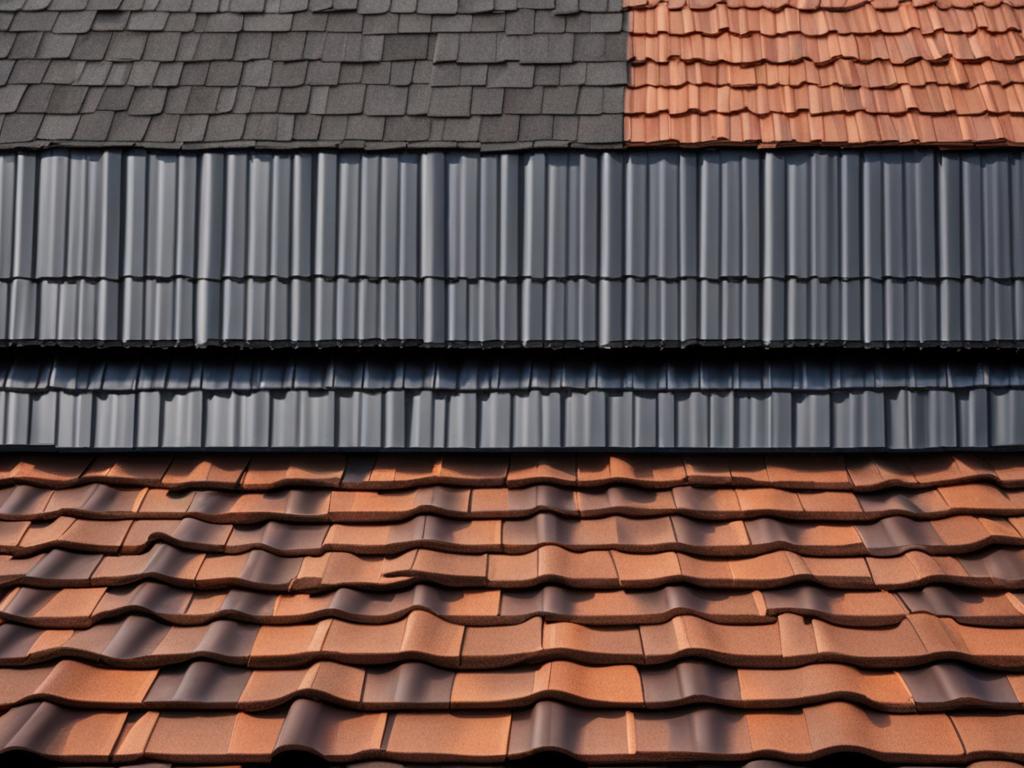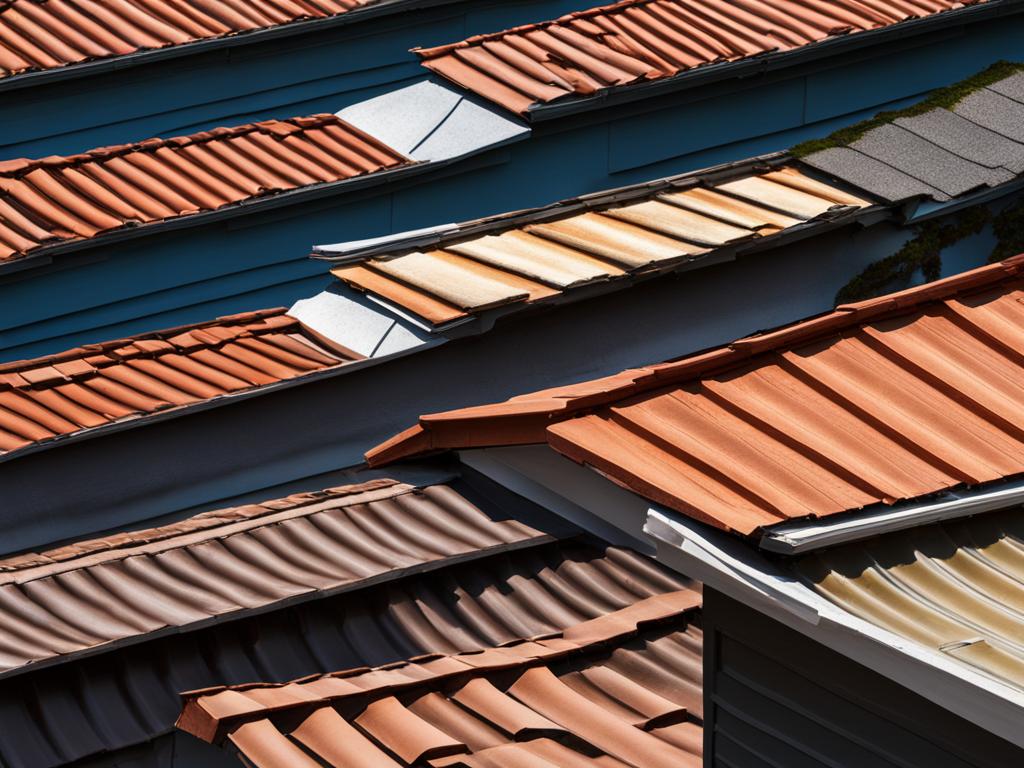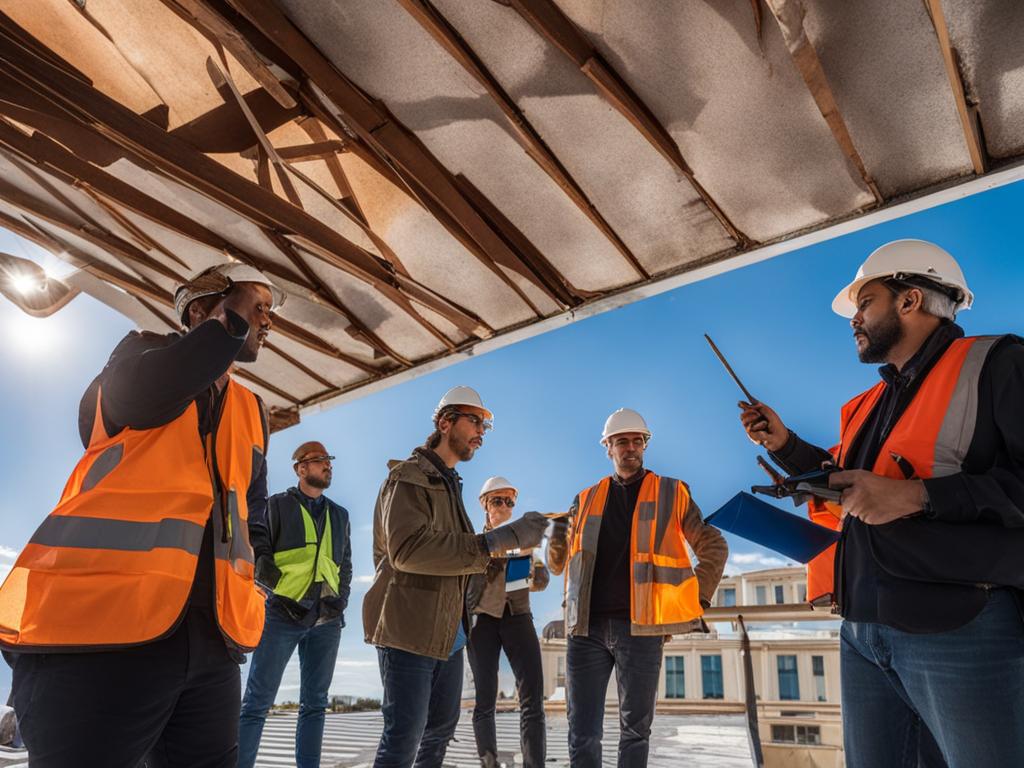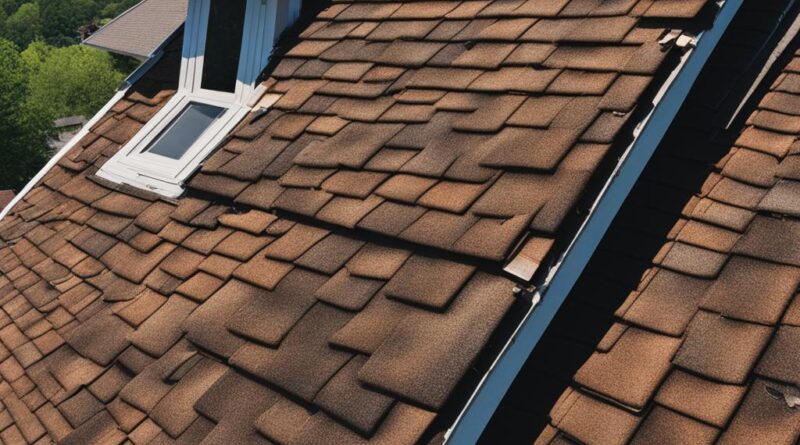Discover How Often Roofs Need to Be Replaced: Key Insights
Your home is one of your biggest investments, so it’s important to protect it. This includes maintaining and replacing your roof when necessary. The lifespan of a roof depends on various factors such as the type of material, climate, installation quality, and the age of the structure. Regular maintenance is also crucial in extending the lifespan of a roof. Consulting with roofing professionals can provide valuable insights and help with decision-making.
Key Takeaways
- Roof lifespan is influenced by factors like material type, climate, and installation quality.
- Regular maintenance is essential for extending the lifespan of your roof.
- Consulting with roofing professionals can provide valuable insights and help with decision-making.
- Different types of roofs have varying lifespans.
- Protecting your home investment includes proper roof maintenance and timely replacements.
The Importance of Regular Maintenance
Regular maintenance plays a crucial role in extending the lifespan of your roof. By implementing preventative repairs and conducting regular inspections, you can identify potential issues before they become major problems. Cleaning debris from your roof also helps to maintain its structural integrity.
Scheduled check-ups and inspections provide an opportunity to spot cracked shingles, damaged flashing, or other signs of wear and tear. By addressing these issues promptly, you can prevent further damage and avoid costly repairs down the line. Additionally, regular cleaning helps to remove leaves, branches, and other debris that can accumulate on your roof and potentially lead to water damage.
“The key to a long-lasting roof is proactive maintenance. By taking care of minor repairs and conducting regular inspections, you can significantly extend the life of your roof and avoid the need for premature replacement.”
Preventative repairs are an essential aspect of roof maintenance. By addressing small problems early on, you can prevent them from escalating into more significant issues that could require a full roof replacement. This not only saves you money in the long run but also helps to preserve the overall integrity of your home.
Regular Maintenance Checklist
- Schedule annual roof inspections by a professional roofing contractor.
- Clean gutters and downspouts regularly to prevent clogs and water damage.
- Trim overhanging tree branches to prevent debris build-up and potential damage from falling limbs.
- Check for cracked or missing shingles and replace them promptly.
- Inspect flashing around chimneys, vents, and skylights for signs of damage or deterioration.
- Remove moss, algae, and other growth from the roof surface.
By following these maintenance guidelines and being proactive in addressing any issues that arise, you can ensure the longevity and durability of your roof.
| Roof Maintenance Tips | Frequency |
|---|---|
| Roof Inspections | Annually |
| Gutter Cleaning | Twice a year (spring and fall) |
| Shingle Replacement | As needed (promptly) |
| Flashing Inspection | Annually |
| Roof Surface Cleaning | As needed (annually or biannually) |
Understanding Different Roofing Materials and Their Durability
When it comes to roofing materials, durability plays a crucial role in determining the lifespan of your roof. Different materials offer varying levels of longevity and performance, so it’s important to choose the right option for your needs. Let’s take a closer look at some popular roofing materials and their durability:
Asphalt Shingles
Asphalt shingles are the most common roofing material in the United States. They are affordable, versatile, and easy to install. However, their durability is relatively moderate compared to other options. On average, asphalt shingle roofs can last around 15-20 years. Regular maintenance and timely repairs can help extend their lifespan.
Metal Roofs
Metal roofs have gained popularity in recent years due to their exceptional durability and longevity. They can withstand harsh weather conditions, including high winds and heavy snowfall. Metal roofs can last 50 years or more with proper installation and regular maintenance. They are also energy-efficient and environmentally friendly.
Slate and Tile
Slate and tile roofs are known for their elegance and longevity. These materials can last significantly longer than asphalt shingles and metal roofs. Slate roofs can have a lifespan of up to 100 years, while tile roofs can last 50-100 years. Although they require a larger upfront investment, their durability makes them a worthwhile long-term investment.
It’s also worth considering the recycling opportunities associated with different roofing materials. Certain materials like metal and asphalt shingles can be recycled, reducing their environmental impact and providing eco-friendly alternatives.
When choosing a roofing material, it’s essential to consider factors beyond durability alone. Factors such as cost, aesthetics, and climate suitability should also be taken into account. Consulting with roofing professionals can provide valuable guidance and help you make an informed decision based on your specific needs and preferences.
| Roofing Material | Durability | Lifespan | Recycling Opportunities |
|---|---|---|---|
| Asphalt Shingles | Moderate | 15-20 years | Recyclable |
| Metal Roofs | High | 50+ years | Recyclable |
| Slate | Very High | Up to 100 years | Non-recyclable |
| Tile | Very High | 50-100 years | Non-recyclable |
Understanding the durability of different roofing materials is crucial in making an informed choice for your home. Consider factors such as lifespan, maintenance requirements, and recycling opportunities to ensure you select a roof that will provide long-lasting protection and value.

Climate Impact on Roof Longevity
The climate in which you live plays a significant role in determining the lifespan of your roof. The weather conditions, including temperature swings, can have a direct impact on the durability and performance of your roof. Extreme weather events such as hurricanes, heavy snowfall, and high winds can cause severe damage, leading to a shorter lifespan for your roof.
Even less dramatic changes in weather can also take a toll on your roof over time. Frequent rain can lead to moisture retention, which can contribute to the deterioration of roofing materials. Excessive heat can cause expansion and contraction, leading to cracks and structural damage. Seasonal changes with significant temperature swings can put stress on the roof, accelerating wear and tear.
It’s important to consider your local climate when choosing roofing materials. Some materials are better suited for specific climates than others. For example, metal roofs are highly resistant to extreme weather conditions and can withstand temperature fluctuations. Additionally, proper insulation and ventilation can help mitigate the impact of climate on your roof, ensuring its longevity.
Table: Lifespan of Roofing Materials in Different Climates
| Roofing Material | Expected Lifespan | Climate Suitability |
|---|---|---|
| Asphalt Shingles | 15-20 years | Suitable for moderate climates |
| Metal Roofs | 50+ years | Highly resistant to extreme weather conditions |
| Slate | 50-100 years | Suitable for colder climates |
| Tile | 50-100 years | Suitable for warmer climates |
By understanding the climate impact on roof longevity, you can make informed decisions when it comes to choosing the right roofing materials and maintaining your roof. Regular inspections and timely repairs can help mitigate the effects of weather conditions and extend the lifespan of your roof. Consulting with roofing professionals can provide valuable insights tailored to your specific climate and help ensure the long-term durability of your roof.
The Role of Proper Installation
Proper installation is a critical factor in ensuring the durability and long lifespan of your roof. Skilled workmanship and attention to detail during the installation process are essential for a reliable and well-functioning roof.
One of the most common installation mistakes is improper flashing. Flashing is the material used to seal joints and prevent water from seeping into the roof. When flashing is not installed correctly, it can lead to leaks and water damage, significantly reducing the lifespan of your roof.
Another installation error to avoid is improper ventilation. Proper ventilation allows air to circulate in the attic and helps regulate the temperature of the roof. Without adequate ventilation, heat and moisture can build up, leading to accelerated deterioration of the roofing materials. This, in turn, can result in increased costs for repairs or even a full replacement.
Skilled Workmanship Makes a Difference
Hiring a reputable and experienced roofing contractor is crucial to ensure proper installation. Skilled workmanship guarantees that every aspect of the roof, from the shingles to the flashing and ventilation systems, is correctly installed.
“Proper installation is the foundation of a long-lasting roof. Investing in skilled workmanship during installation pays off in the long run by providing a reliable and durable roof.” – [Roofing Professional Name], [Company Name]
When you cut corners or choose an inexperienced contractor to save money on installation, you risk compromising the integrity of your roof. Poor installation can lead to premature repairs and a shorter lifespan for your roof, ultimately costing you more in the long term.
By prioritizing proper installation and choosing a skilled roofing professional, you can ensure that your roof is built to last. A well-installed roof not only increases the lifespan of your roof but also provides peace of mind knowing that your home is protected from the elements.
| Common Installation Mistakes | Impact on Roof Lifespan |
|---|---|
| Improper flashing | Leakage and water damage, reduced lifespan |
| Improper ventilation | Accelerated deterioration, increased repair costs |
Age of the Current Structure
The age of your home plays a significant role in determining the lifespan of your roof. Older structures may require special care and more frequent replacements due to differences in building materials and construction methods. The structural stability of the building should also be considered when assessing the condition of the roof.
Regular inspections are crucial for evaluating the age-related wear and tear on the roof. These inspections help identify potential issues early on and allow for prompt repairs or replacements. It is essential to conduct regular check-ups to ensure that the roof remains in good condition and can withstand the test of time.
Preservation requirements for historical homes add an extra layer of complexity when it comes to roof maintenance. These structures often have unique architectural elements and materials that require specialized care. Balancing the structural stability of the roof while preserving the historical integrity of the building is of utmost importance.

Table: Lifespan of Different Roofs Based on the Age of the Structure
| Roof Type | Lifespan |
|---|---|
| Asphalt Shingles | 20-30 years |
| Metal Roofs | 40-70 years |
| Tile Roofs | 50-100 years |
| Slate Roofs | Up to 100 years |
Indicators of Necessary Replacement
When it comes to determining whether your roof needs to be replaced, there are several key indicators to look out for. These signs of damage can help you make an informed decision and avoid costly repairs down the line.
One of the most noticeable signs of roof damage is cracked or missing shingles. These can be caused by various factors such as age, weather conditions, or poor installation. If you notice any shingles that are cracked, curled, or completely gone, it may be time to consider a replacement.
Leaks are another clear indication that your roof is in need of attention. If you notice water stains or dampness in your attic or ceiling, it’s important to address the issue promptly. Ignoring leaks can lead to further damage to your home’s structure and potentially costly repairs.
Dark streaks or patches on your roof can also be a sign of damage. These can be caused by algae or mold growth, which can weaken the integrity of your roof. If you notice any discoloration on your roof, it’s important to have it inspected by a professional to determine the extent of the damage.
Other indicators of necessary roof replacement include light coming through the attic, sagging spots on the roof, and an increase in energy bills. If you can see light coming through your attic or notice any sagging areas on your roof, it’s crucial to address these issues as they may indicate structural damage. Additionally, a problematic roof can lead to poor insulation, causing your energy bills to rise due to increased heating or cooling needs.
By paying attention to these indicators of necessary replacement, you can ensure the longevity and structural integrity of your home. Consulting with roofing professionals can provide further guidance and help you make an informed decision regarding your roof.
Table: Signs of Roof Damage
| Signs of Roof Damage |
|---|
| Cracked or missing shingles |
| Leaks and water stains |
| Dark streaks or patches on the roof |
| Light coming through the attic |
| Sagging spots on the roof |
| Increase in energy bills |
It’s important to address any signs of roof damage promptly to avoid further complications and costly repairs.
Consultation with Roofing Professionals
When it comes to making decisions about your roof, consulting with roofing professionals is key. Their expert advice and insights can help you navigate the signs of wear and tear, estimate costs, and make informed decisions for your home.
Roofing professionals have the knowledge and experience to identify potential issues with your roof that may not be immediately apparent. They can assess the condition of your roof and provide expert advice on whether a replacement is necessary or if repairs will suffice.
“Consulting with a roofing professional can save you time, money, and headaches in the long run. They can provide a thorough inspection and cost estimation, ensuring that you have all the information you need to make the best decision for your roof.”
In addition to their expertise, roofing professionals can provide valuable insights into different roofing options that may be suitable for your home. They can guide you through the process of selecting the right materials, taking into consideration factors such as durability, aesthetics, and your specific needs.
By consulting with roofing professionals, you can gain peace of mind knowing that you have made an informed decision about your roof and have taken the necessary steps to protect your home for years to come.

Different Types of Roofs and How Often to Replace
When it comes to roof replacement, different types of roofs have varying lifespans. Understanding the lifespan of your specific roof type is essential for proper maintenance and planning. Here are the average lifespans of popular roof types:
| Roof Type | Lifespan |
|---|---|
| Asphalt Shingles | 20-30 years |
| Metal Roofs | 40-70 years |
| Tile Roofs | 50-100 years |
| Slate Roofs | Up to 100 years |
Asphalt shingle roofs are the most common in the United States and typically last between 20 to 30 years. This type of roof is cost-effective and offers a variety of styles and colors. Metal roofs, on the other hand, have greater longevity and can last anywhere from 40 to 70 years. They are known for their durability and energy efficiency.
If you’re looking for a roof with an even longer lifespan, consider tile or slate roofs. Tile roofs can last between 50 to 100 years, depending on the specific material used. They offer exceptional resistance to fire, insects, and rot. Slate roofs are the most durable, with a lifespan that can exceed 100 years. However, they come with a higher price tag and require specialized installation techniques.
It’s important to note that these lifespans are averages and can vary depending on factors such as maintenance, climate, and installation quality. Regular inspections and proper maintenance can help extend the lifespan of any roof type.
Conclusion
In conclusion, maintaining and replacing your roof when necessary is crucial for protecting your home, one of your biggest investments. The lifespan of a roof depends on various factors such as maintenance, roof type, climate, installation quality, and the age of the structure. Regular maintenance, including scheduled check-ups, inspections, and cleaning debris, is vital in extending the lifespan of your roof. Preventative repairs help avoid future damage and save you from costly repairs. Proper installation by skilled professionals ensures a reliable and long-lasting roof.
Consulting with roofing professionals is highly recommended when making decisions about your roof. They can provide expert advice, identify signs of wear and tear, and give cost estimations. Different types of roofs have different lifespans, so it’s important to consider the specific type of roof you have when determining when it needs to be replaced. Asphalt shingle roofs typically last 20-30 years, while metal roofs can last 40-70 years. Tile roofs have a lifespan of 50-100 years, and slate roofs can last up to 100 years.
By considering these factors and consulting with professionals, you can make informed decisions about roof replacement. Remember, regular maintenance and proper installation are key in maximizing the lifespan of your roof. Protect your investment and ensure the long-term integrity of your home by taking care of your roof.
FAQ
How often do roofs need to be replaced?
The lifespan of a roof depends on various factors such as the type of material, climate, installation quality, and the age of the structure. Regular maintenance and proper installation are crucial in extending the lifespan of a roof.
Why is regular maintenance important for roofs?
Regular maintenance, including scheduled check-ups, inspections, and cleaning debris, helps identify potential issues before they become major problems. Preventative repairs are also important in avoiding future damage and extending the life of your roof.
What are the different types of roofing materials and their durability?
The durability of roofing materials varies. Asphalt shingles, the most common material in the US, last around 15-20 years. Metal roofs can last 50 years or more, while materials like slate and tile offer extended lifespans. Consider recycling opportunities when choosing a roof, as certain materials are highly recyclable and eco-friendly.
How does climate impact roof longevity?
Extreme weather conditions like hurricanes, heavy snowfall, and high winds can cause severe damage and shorten a roof’s lifespan. Even less dramatic changes in weather, like frequent rain or excessive heat, can wear down roofing materials over time. Seasonal changes with significant temperature swings can also stress the material, leading to cracks and damage.
What role does proper installation play in roof lifespan?
Proper installation is vital for preserving the durability and longevity of your roof. Skilled workmanship ensures that every part of the roof is installed correctly, from shingles to flashing and ventilation systems. Cutting corners during installation can lead to premature repairs and even full replacement.
How does the age of the structure impact roof lifespan?
The age of your home influences the lifespan of your roof. Older structures may require special care and frequent replacements due to differences in building materials and construction methods. Regular inspections are crucial for assessing the condition of the roof and identifying potential issues.
What are the indicators that a roof needs replacement?
Indicators include cracked or missing shingles, leaks, dark streaks or patches on the roof, light coming through the attic, and sagging spots. Consideration of replacement costs is also important, as frequent repairs can exceed the cost of a new installation. A problematic roof can also lead to increased energy bills due to inefficiency in home insulation.
Why should I consult with roofing professionals?
When in doubt about whether to replace your roof, consulting with roofing professionals is a smart move. They have the expertise to identify signs of wear and tear that may not be obvious to an untrained eye. They can also provide advice on whether a replacement is necessary or if repairs will suffice. Roofing professionals can give cost estimations to help with financial planning and ensure informed decisions are made regarding your roof.
How often do different types of roofs need to be replaced?
Different types of roofs have varying lifespans. Asphalt shingle roofs typically last 20-30 years, while metal roofs can last 40-70 years. Tile roofs have a lifespan of 50-100 years, and slate roofs can last up to 100 years. It’s important to consider the type of roof you have when determining how often it needs to be replaced.
What should I consider when it comes to roof replacement?
The lifespan of a roof depends on various factors such as maintenance, roof type, climate, installation quality, and the age of the structure. Regular maintenance and proper installation are crucial in extending the lifespan of a roof. Consulting with roofing professionals can provide valuable insights and help with decision-making.

